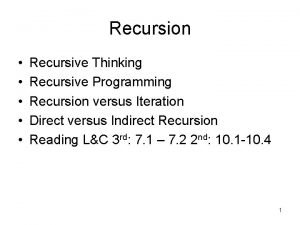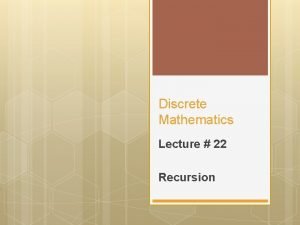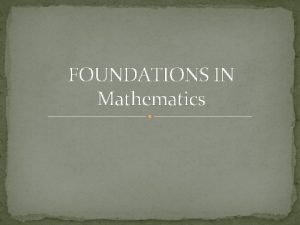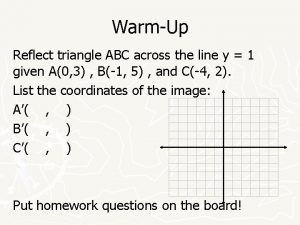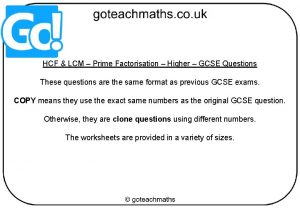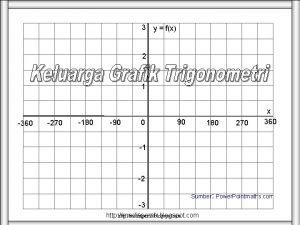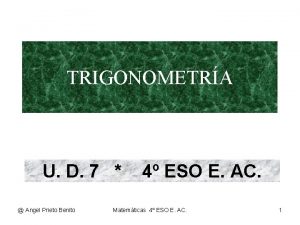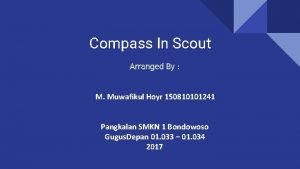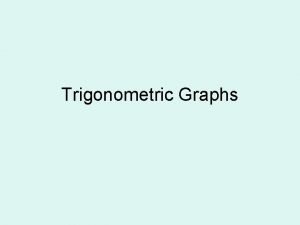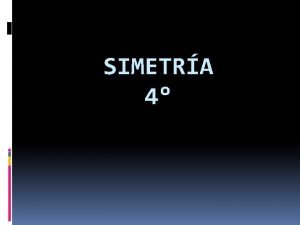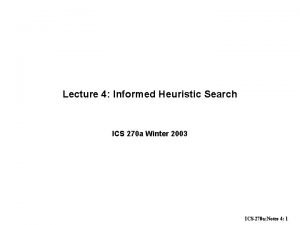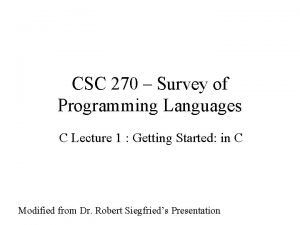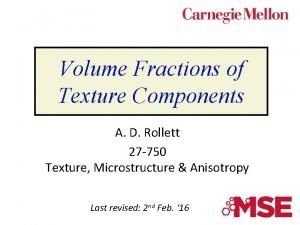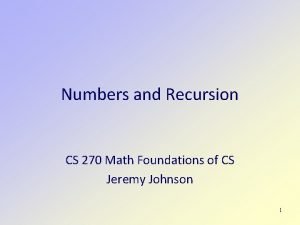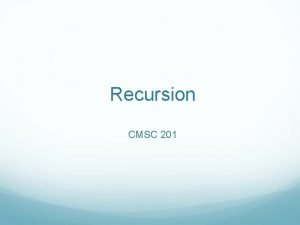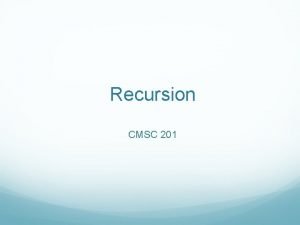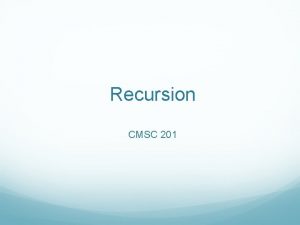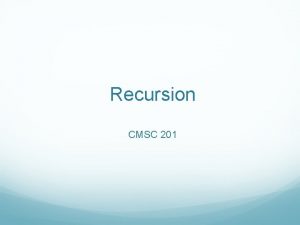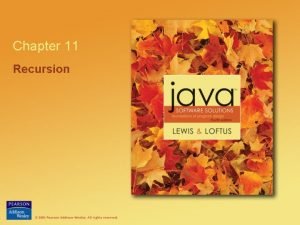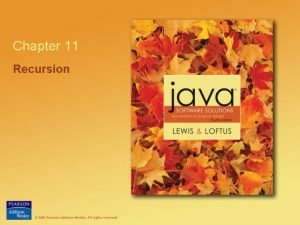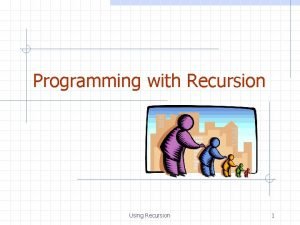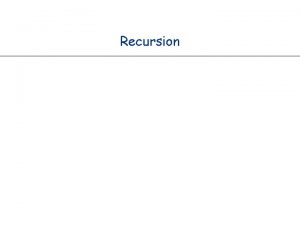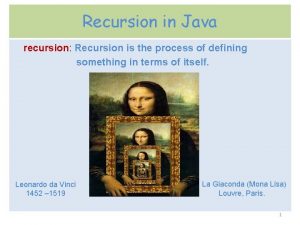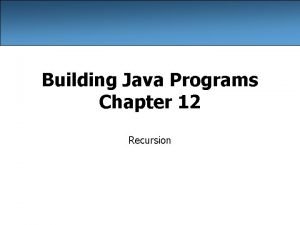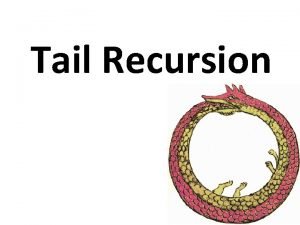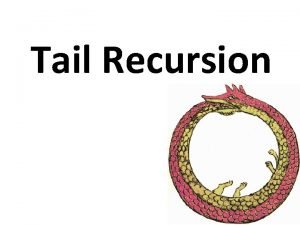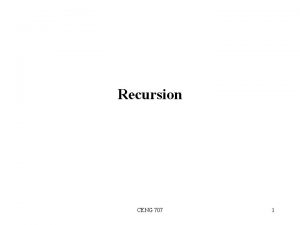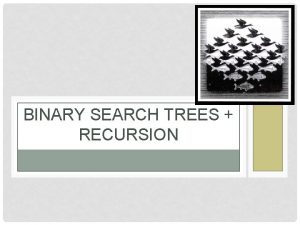Lists and Recursion CS 270 Math Foundations of



![Building Lists > (list x 1 … xn) [macro – variable # of args] Building Lists > (list x 1 … xn) [macro – variable # of args]](https://slidetodoc.com/presentation_image_h2/cdb0f7db78b58c4a83572ac578165be4/image-4.jpg)


![More About cons A cons cell contains two fields first [also called car] rest More About cons A cons cell contains two fields first [also called car] rest](https://slidetodoc.com/presentation_image_h2/cdb0f7db78b58c4a83572ac578165be4/image-7.jpg)




![Version 3 of list? (define (list? l) (cond [(null? l) #t] [(cons? l) (list? Version 3 of list? (define (list? l) (cond [(null? l) #t] [(cons? l) (list?](https://slidetodoc.com/presentation_image_h2/cdb0f7db78b58c4a83572ac578165be4/image-12.jpg)


![Member 1 (define (member x l) (cond [(null? l) #f] [ ])) 1. Member Member 1 (define (member x l) (cond [(null? l) #f] [ ])) 1. Member](https://slidetodoc.com/presentation_image_h2/cdb0f7db78b58c4a83572ac578165be4/image-15.jpg)













- Slides: 28

Lists and Recursion CS 270 Math Foundations of CS Jeremy Johnson 1

Objective • To provide a recursive definition of lists and several recursive functions for processing lists that mimic the recursive definition • To practice using recursive data structures and writing recursive functions in Racket 2

Fundamental List Functions L = (x 1 … xn) null? : All → Boolean cons : All × List → Cons (cons x L) = (x x 1 … xn) first : Cons → All (first (cons x L)) = x rest : Cons → List (rest (cons x L)) = L 3
![Building Lists list x 1 xn macro variable of args Building Lists > (list x 1 … xn) [macro – variable # of args]](https://slidetodoc.com/presentation_image_h2/cdb0f7db78b58c4a83572ac578165be4/image-4.jpg)
Building Lists > (list x 1 … xn) [macro – variable # of args] (cons x 1 (cons x 2 … (cons xn nil)…)) > (cons? ‘()) => #f > (null? ‘()) => #t > (cons 1 ‘()) => ‘(1) (cons? (cons 1 ‘())) => #t (cons 1 (cons 2 (cons 3 ‘()))) => ‘(1 2 3) (list 1 2 3) => ‘(1 2 3) (cons 1 ‘()) => ‘((1)) 4

Exercise How do you construct the list ((1) 2)? 5

Exercise How do you construct the list ((1) 2)? (cons 1 ‘()) = (1) (cons 2 ‘()) = (2) Want (cons x y) where x = ‘(1) and y = ‘(2) (cons 1 ‘()) (cons 2 ‘())) => ‘((1) 2) Test this (and try additional examples) in Dr. Racket 6
![More About cons A cons cell contains two fields first also called car rest More About cons A cons cell contains two fields first [also called car] rest](https://slidetodoc.com/presentation_image_h2/cdb0f7db78b58c4a83572ac578165be4/image-7.jpg)
More About cons A cons cell contains two fields first [also called car] rest [also called cdr] For a list the rest field must be a list Generally both fields of a cons All (cons 1 2) = (1. 2) Called a dotted pair 7

Recursive Definition • Recursive Definition List : empty | cons All List Process lists using these two cases and use recursion to recursively process lists in cons • Use null? to check for empty list and cons? to check for a cons • Use first and rest to access components of cons 8

Recursion and list? 1 (define (list? l) (if (cons? l) (list? (rest l)) (null? l ))) 1. list? is a built-in function in Racket 9

Incorrect list? • Nonterminating • Input to recursive call must get smaller! (define (list? l) (if (cons? a) (list? l) (null? l))) 10

Version 2 of list? (define (list? l) (if (null? l) #t (if (cons? l) (list? (rest l)) #f))) 11
![Version 3 of list define list l cond null l t cons l list Version 3 of list? (define (list? l) (cond [(null? l) #t] [(cons? l) (list?](https://slidetodoc.com/presentation_image_h2/cdb0f7db78b58c4a83572ac578165be4/image-12.jpg)
Version 3 of list? (define (list? l) (cond [(null? l) #t] [(cons? l) (list? (rest l))] [else #f])) 12

Length 1 (define (length l) (if (null? l) 0 ( ) )) 1: length is a built-in function in Racket 13

Length 1 (define (length l) (if (null? l) 0 (+ 1 (length (rest l))) )) • The recursive function can be “thought of” as a definition of length 1: length is a built-in function in Racket 14
![Member 1 define member x l cond null l f 1 Member Member 1 (define (member x l) (cond [(null? l) #f] [ ])) 1. Member](https://slidetodoc.com/presentation_image_h2/cdb0f7db78b58c4a83572ac578165be4/image-15.jpg)
Member 1 (define (member x l) (cond [(null? l) #f] [ ])) 1. Member is a built-in function in Racket and the specification is different 15

Member 1 (defun (member x l) (cond [(null? l) #f) [(equal x (first l)) #t] [else (member x (rest l))])) 1. Member is a built-in function in Racket and the specification is different 16

Append 1 (define (append x y) … ) • (append ‘(1 2 3) ‘(4 5 6)) (1 2 3 4 5 6) • Recurse on the first input 1. append is a built-in function in Racket 17

Append 1 (define (append x y) (if (null? x) y (cons (first x) (append (rest x) y)))) • Recurse on the first input 1. append is a built-in function in Racket 18

Reverse 1 (define (reverse l) … ) • (reverse ‘(1 2 3)) (3 2 1) 1. reverse is a built-in function in Racket 19

Reverse 1 (define (reverse l) (if (null? l) ‘() (append (reverse (rest l)) (cons (first l) ‘())))) 1. reverse is a built-in function in Racket 20

Tail Recursive reverse (define (reverse-aux x y) (if (null? x) y (reverse-aux (rest x) (cons (first x) y)))) (define (reverse x) (reverse-aux x ‘())) • O(n) vs O(n 2) 21

Numatoms (define (atom? x) (not (cons? x))) ; return number of non-null atoms in x (define (numatoms x) (cond [(null? x) 0] [(atom? x) 1] [(cons? x) (+ (numatoms (first x)) (numatoms (rest x)))])) 22

Shallow vs Deep Recursion • Length and Member only recurse on the rest field for lists that are conses • Such recursion is called shallow – it does not matter whether the lists contain atoms or lists • (length ‘((1 2) 3 4)) => 3 • Numatoms recurses in both the first and rest fields • Such recursion is called deep – it completely traverses the list when elements are lists • (numatoms ‘((1 2) 3 4)) => 4 23

Termination • Recursive list processing functions, whether shallow or deep must eventually reach the base case. • The inputs to each recursive call must have a smaller size • Size is the number of cons cells in the list • (< (size (first l)) (size l)) • (< (size (rest l)) (size l)) 24

Size (define (atom? x) (not (cons? x))) ; return size of x = number of cons cells in x (define (size x) (cond [(atom? x) 0] [(null? x) 0] [(cons? x) (+ 1 (size (first x)) (size (rest x)))])) 25

Order ; return the order = maximum depth (define (order x) (cond [(null? x) 0] [(atom? x) 0] [(cons? x) (max (+ 1 (order (first x))) (order (rest x)))])) 26

Order Using map/reduce ; return the order = maximum depth (define (order x) (cond [(null? x) 0] [(atom? x) 0] [(cons? x) (+ 1 (foldr max 0 (map order x)))])) 27

Flatten Using map/reduce ; return a first order list containing all atoms in x (define (flatten x) (cond [(null? x) x] [(atom? x) (list x)] [(cons? x) (foldr append '() (map flatten x))])) 28
 To understand recursion you must understand recursion
To understand recursion you must understand recursion Recursion math
Recursion math What is recursion in discrete mathematics
What is recursion in discrete mathematics Preschool learning foundations math
Preschool learning foundations math Preschool learning foundations math
Preschool learning foundations math What is this image
What is this image Rotations in the coordinate plane
Rotations in the coordinate plane 270 towin
270 towin Legea 270 din 2018 cu modificari
Legea 270 din 2018 cu modificari Interceptor nomaki
Interceptor nomaki Hcf of 90
Hcf of 90 270 towin.com
270 towin.com Umich eecs 270
Umich eecs 270 180 degree rotation formula
180 degree rotation formula Sin 270
Sin 270 Csc 270
Csc 270 Ctg 270
Ctg 270 360 - 270
360 - 270 Zodiac futura fastroller
Zodiac futura fastroller Trigonometral
Trigonometral Arah mata angin primer
Arah mata angin primer Sinx+1 graph
Sinx+1 graph 270 to win.com
270 to win.com Figuras asimetricas
Figuras asimetricas Heuristic function
Heuristic function Csc of 270
Csc of 270 Class complex
Class complex Eecs 270
Eecs 270 Express 45/270 as a fraction reduced to its lowest terms
Express 45/270 as a fraction reduced to its lowest terms

